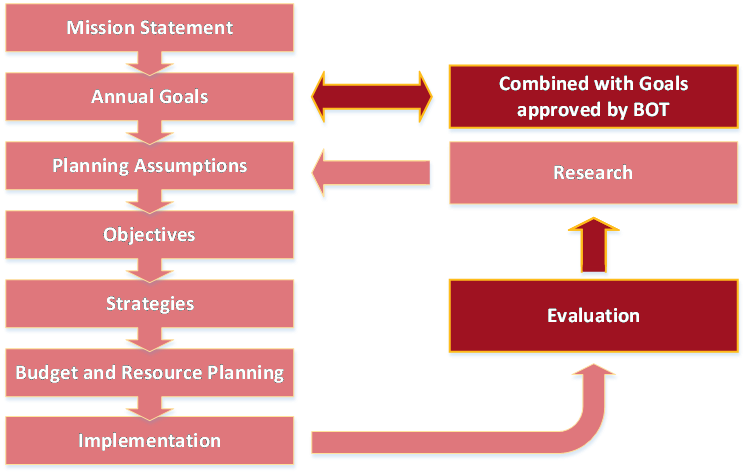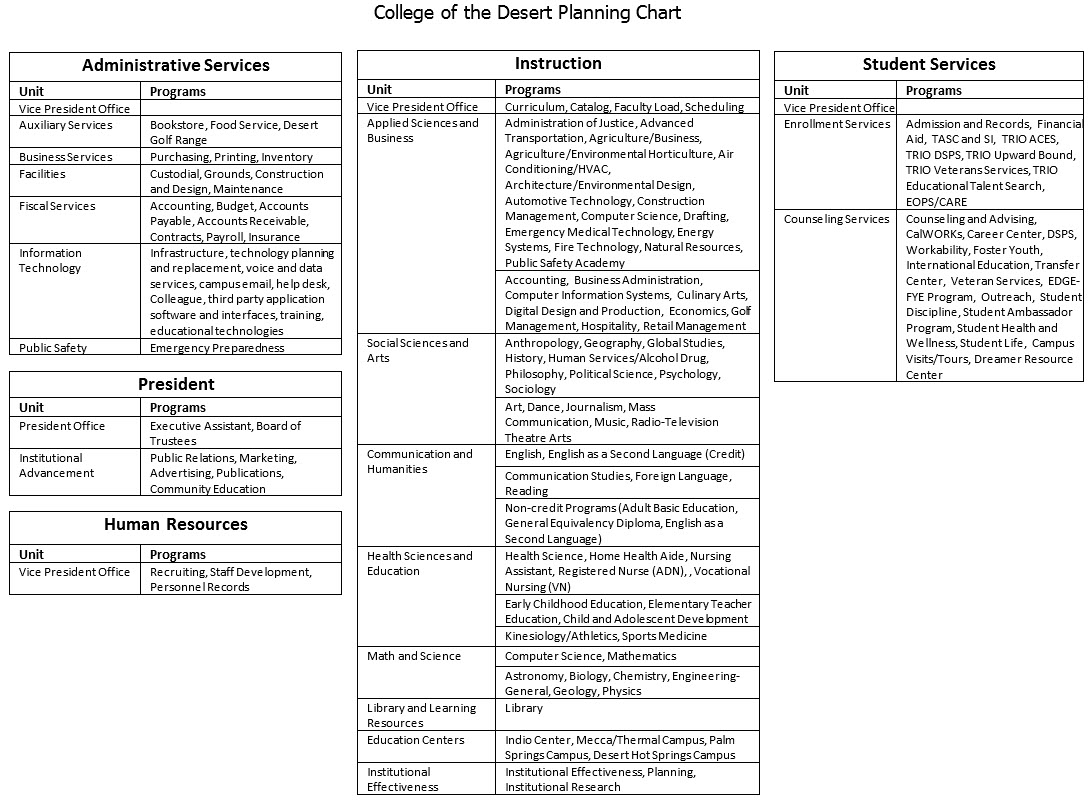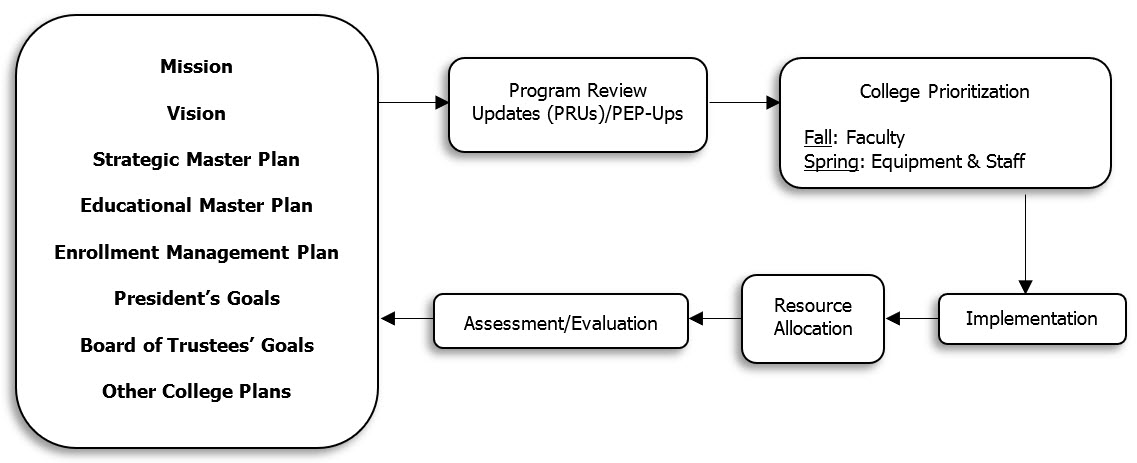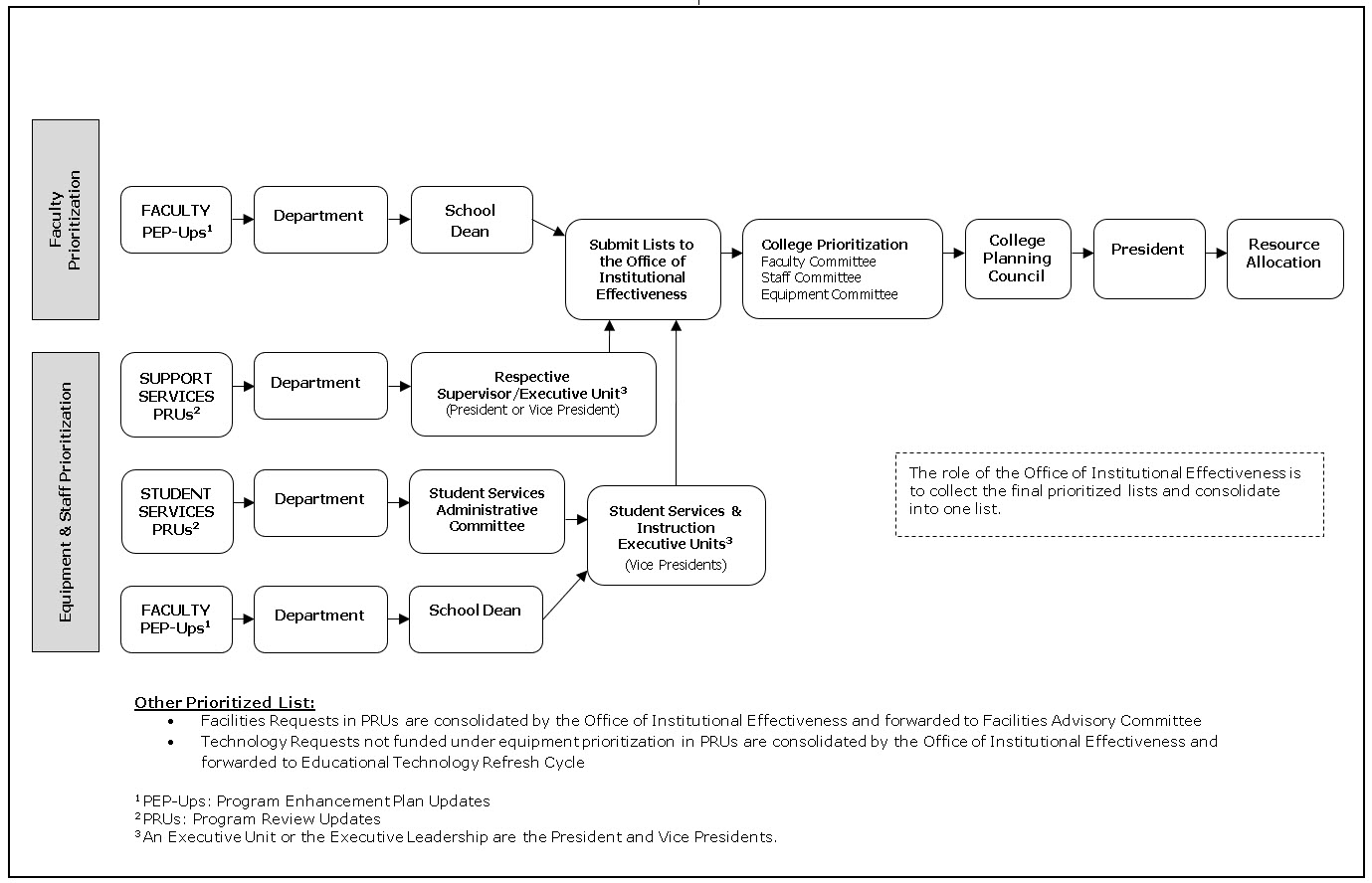Planning and Institutional Effectiveness (PIE) Process
Introduction
College of the Desert takes seriously its commitment to student success, achievement and quality in every aspect of the institution. COD assesses its effectiveness for accountability purposes to the public, the state legislature and various accrediting agencies. The Accrediting Commission of Community and Junior Colleges (ACCJC) requires that colleges have an on-going, institution-wide planning and evaluation process that results in continuing improvement and demonstrates the college is effectively accomplishing its mission. COD’s institutional effectiveness process is designed to capture, organize and report evidence that complies with this requirement.
The Planning Process
Planning is the process by which the college accomplishes its mission. Through the planning process, College of the Desert uses a “bottom-up” approach to planning organized around four levels of planning. The first level is the department, such as Accounting in the Applied Sciences and Business Division, Financial Aid Office within Enrollment Services, or Maintenance and Operations within Administrative Services. The next level of planning are areas that have respective department supervisors, directors, faculty coordinators/chairs and/or Deans. The third level of planning are the four Executive areas: Office of the President, Student Services, Instruction and Administrative Services. The fourth and largest planning area is the entire college. The college level plan is developed by the College Planning Council and its task forces or committees. Please refer to the College of the Desert Planning Chart for all the departments, respective department supervisors, directors, chairs, Dean areas and Executive areas (Office of the President, Student Services, Instruction and Administrative Services).
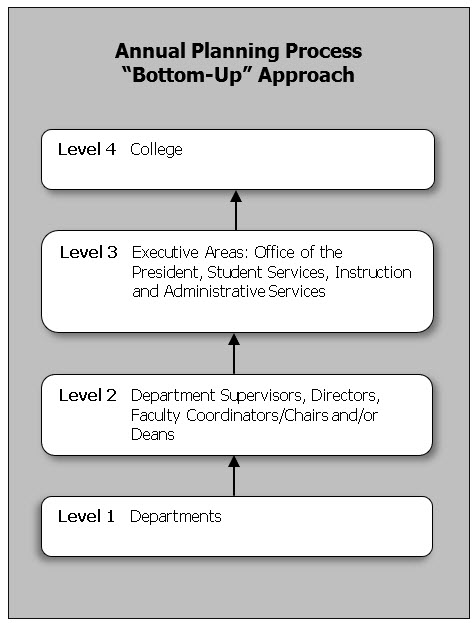
Strategic Planning Process
Annual Planning Process
This planning process is intended to respond to the College mission, goals in existing College plans (Strategic Master Plan, Educational Master Plan, Enrollment Management plan, etc.), program review goals and the goals and objectives announced by the President for the respective year. Departments should consider these goals when completing their annual Program Review Updates (PRU)/PEP-Ups.
-
March 15 is the due date for all areas, PEP-Ups and PRUs.
-
Faculty prioritization occurs in Fall.
-
Staff and Equipment prioritizations occur in Spring.
-
Leadership requests from PRUs are consolidated and submitted to the Executive Cabinet (President and Vice Presidents) for review.
-
Facilities requests from PRUs are consolidated and submitted to the Facilities Advisory Committee for review.
-
Technology requests are consolidated and prioritized under non-instructional equipment.
-
The remaining technology requests consolidated from the PRUs are submitted to the Office of Educational Technology to see if any of the requests are being replaced as part of the refresh cycle as stated in the Technology Master Plan.
For current timelines, forms and documents, please refer to the College portal under College Planning Council, the Office of Institutional Effectiveness and/or Outcomes and Assessment Committee, a standing committee of the Academic Senate.
Office of Institutional Effectiveness
Outcomes and Assessment Committee (Requires Login)
Comprehensive Program Review
The Program Enhancement Plan (PEP) is a five-year comprehensive program review and plan. The purposes of a PEP are improvement, alignment with established objectives, and planning for the future, rather than a process to secure approval or endorsement from a body of reviewers. The program review and plan process provides opportunities for programs to review their accomplishments, examine their strengths and weaknesses, and develop plans through which improvements in their effectiveness can be achieved. Conclusions and recommendations will be used in department, division, College, and strategic planning processes.
The PEP-Up is the annual update to the PEP which is used to report the major changes that have occurred in a program as well as to report student learning outcome assessment activities.
Criteria for Determining Allocations to Ongoing Budget
Criteria and procedures are for unrestricted funds only. Restricted funds, such as categorical, bond, grants, etc., have criteria set by law, California Codes or regulations that control changes or distribution of funding. For current criteria for faculty, staff and equipment prioritization, please visit Prioritization Documents.
Click on the most current prioritization folder, then click on the faculty prioritization folder for its current criteria or click on the staff and equipment folder for the current criteria for that respective prioritization.
Procedures for Determining Allocation to Ongoing Budget
The College will determine the available resources for resource allocation. Work in this area can be referred to the Budget Subcommittee, a standing subcommittee of the College Planning Council. Institutional data, information from the PRUs, the prioritization processes and/or committee recommendations will inform resource allocation for requesting positions and items. The prioritized lists will be presented to the President. The College President will make final resource allocation decisions based on data, college input and the prioritization process.
The Budget Subcommittee establishes the guidelines and timelines for the preparation of the unrestricted and designated budgets. The subcommittee will review the estimated revenue projections for the upcoming fiscal year to determine total funds available as well as projections for future years. The subcommittee will review prioritized funding requests as submitted by the College Planning Council as well as the Technology Replacement Plan and will recommend allocation and reallocation/reductions of resources to the strategic plans. The recommended annual unrestricted and designated budgets will be forwarded to College Planning Council.
Procedures for Funding New Programs
Requests for resource allocation for a new program should follow our local policy for program viability.
Procedures for Reducing and Eliminating Funding
This procedure is parallel to the one for providing funding. The College will determine the amount of revenue shortfall and/or state budget reductions and the amount of total Unrestricted General Fund reduction required to maintain a balanced budget with the required reserve. Work in this area can be referred to the Budget Subcommittee, a standing subcommittee of the College Planning Council.
Note: This procedure assumes a timeline which would allow the process to unfold. In an emergency, the President, President’s Cabinet and/or College Planning Council could take immediate steps.
-
Deans, Directors, Vice Presidents and President will be requested to submit possible reductions in programs and services for review by the College Planning Council.
-
Program review data will be provided when available, and applied if useful and appropriate.
-
The College Planning Council will review and analyze.
-
Summary notes should be included showing the impact of the reduction on campus/student needs, college goals and consistency with the criteria for determining allocation to ongoing budgets.
-
With this information, the College Planning Council will develop a proposed list of budget reductions with a rationale for the reductions and a probable impact on students, and proposed listing of fund restorations to be implemented when the funding exigency has passed. The College Planning Council will offer final suggestions and recommendations to the President.
-
The President will make final budget reduction decisions based on recommendations from the College Planning Council.
Procedures for Allocating New Full-Time Teaching and Non-Teaching Faculty Positions
The Budget Sub-Committee communicates to the College Planning Council the number of available positions early in the fall semester based on revenue projections, education code and Title 5 requirements.
-
The President’s Cabinet estimates additional positions that might become available due to unannounced retirements/resignations as data/information is collected from Human Resources.
-
The Vice President of Instruction and the Vice President Student Services assemble data listed in the “Criteria that should be used” for all disciplines that have an objective on the Priority List with an associated fulltime faculty need.
-
The Deans’ Team develops a recommended ranked list of disciplines requesting positions using the data and the “Criteria for Determining New Full-time Teaching Faculty Positions.”
-
The College Planning Council develops an approved list of positions, taking into consideration the number of positions established by the Budget Sub-Committee and other available funding sources. If, later in the academic year, new faculty needs emerge due to an unanticipated vacancy, the division will prioritize an appropriate objective within its division list and submit it through the prioritization process for placement on the established college list. If the discipline need for full time faculty has been established and the hire has been approved, the vacancy may be filled from the candidate pool.
-
The College Planning Council will forward recommendations along with rationale for the Council’s recommendation to the President.
-
The President will make final decision on faculty hires based on recommendations from the College Planning Council.
For current criteria and data points for allocating faculty positions, please visit Prioritization Documents. (Requires login to Portal)
Faculty Prioritization Process
As stated earlier, faculty positions are requested through the Program Review process. The Faculty Prioritization Committee is a 12-member committee with both leadership and faculty representatives. There is a detailed process, timeline, and rubric to determine the faculty hiring needs of the college. Please refer to Appendix I for the approved Faculty Prioritization process.
Staff Prioritization Process
As stated earlier, staff positions are requested through the Program Review process. The Staff Prioritization Committee is a 12-member committee with leadership, faculty, and classified representatives. There is a detailed process and timeline, and rubric to determine the staff hiring needs of the college. Please refer to Appendix J for the approved Staff Prioritization process.
Equipment Prioritization Process
As stated earlier, equipment is requested through the Program Review process. The Equipment Prioritization Committee includes the five members of Executive Cabinet, the six Academic Senate Executive Committee members, six deans, 15 department chairs, and a classified representative. There is a detailed process, timeline, and rubric to determine the equipment needs of the college. Please refer to Appendix L for the approved Equipment Prioritization process.
Other Requests for Funding
Emergencies, exigencies and/or special occasions when unplanned events do occur and require new funding, the President shall determine and approve the source of funds.
CTE, Categorical, Grant Funding
All planned projects regardless of funding sources – whether the college general fund, career technology, categorical, i.e., DSPS, EOPS, Matriculation, and grants – must be included in the program review update. All activities connected to specialized plans (technology, facilities, instructional, etc.) must also be included in the plans. The guiding principle is all projects that are focused on improving the program, even if a grant is funding the project and no college resources are being sought. This will facilitate the coordination of activities in the program and college as well as the integration with the planning process.

